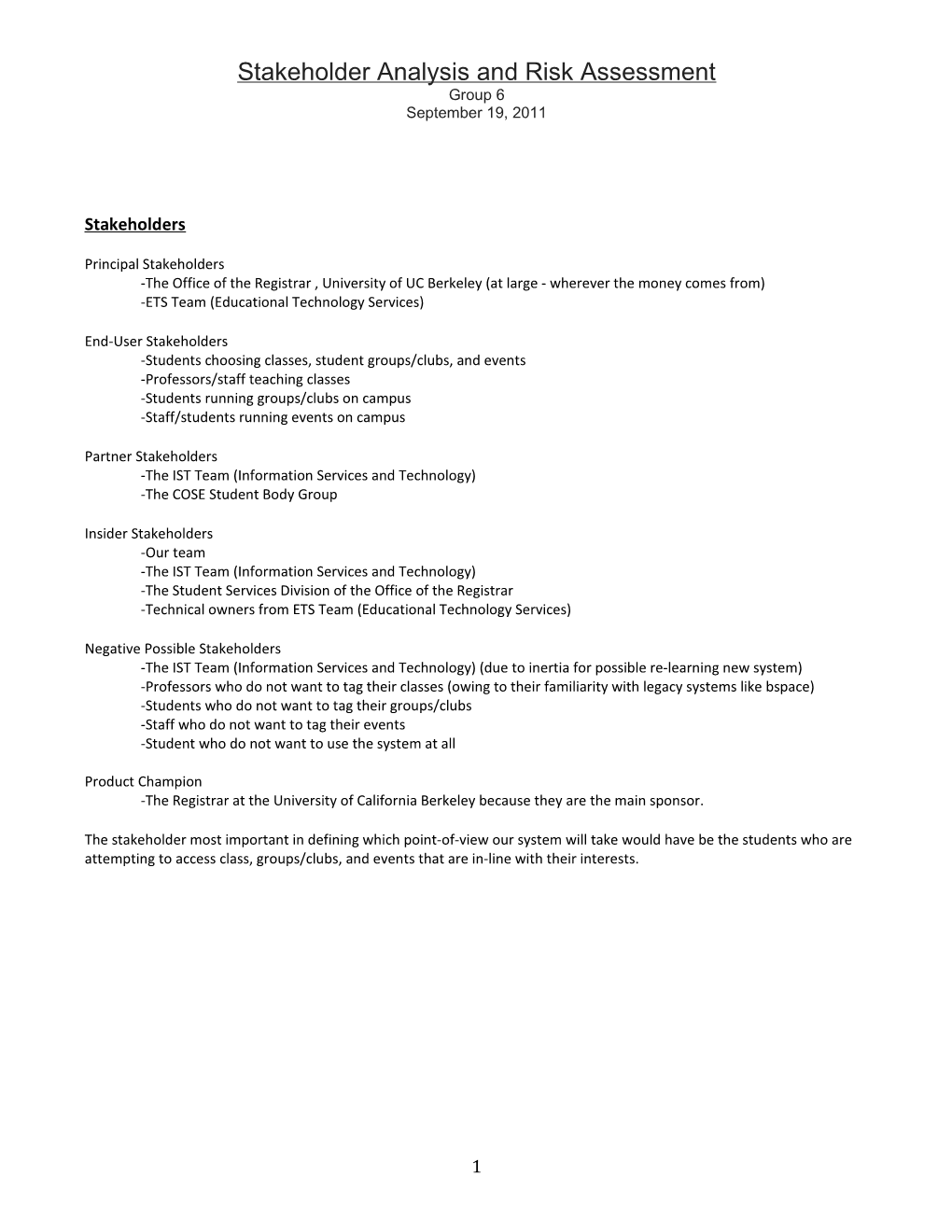Stakeholder Analysis and Risk Assessment
Group 6
September 19, 2011
Stakeholders
Principal Stakeholders
-The Office of the Registrar , University of UC Berkeley (at large - wherever the money comes from)
-ETS Team (Educational Technology Services)
End-User Stakeholders
-Students choosing classes, student groups/clubs, and events
-Professors/staff teaching classes
-Students running groups/clubs on campus
-Staff/students running events on campus
Partner Stakeholders
-The IST Team (Information Services and Technology)
-The COSE Student Body Group
Insider Stakeholders
-Our team
-The IST Team (Information Services and Technology)
-The Student Services Division of the Office of the Registrar
-Technical owners from ETS Team (Educational Technology Services)
Negative Possible Stakeholders
-The IST Team (Information Services and Technology) (due to inertia for possible re-learning new system)
-Professors who do not want to tag their classes (owing to their familiarity with legacy systems like bspace)
-Students who do not want to tag their groups/clubs
-Staff who do not want to tag their events
-Student who do not want to use the system at all
Product Champion
-The Registrar at the University of California Berkeley because they are the main sponsor.
The stakeholder most important in defining which point-of-view our system will take would have be the students who are attempting to access class, groups/clubs, and events that are in-line with their interests.
Other Ways of Classifying Stakeholders:
Mitchell's taxonomy [power, legitimacy, urgency]
1.
2.School faculty and staff
3. Students in UCB
4. IST team
5.
6. COSE
7. ETS project manager
Alexander's Onion Classification
The Kit: The Interest Tagging Engine
The System: ETS, us (the four members of the team)
The Containing System: all the students, faculties, and staff in UC Berkeley
The Wider Environment: OAE (Open Academic Environment)
Sutcliffe's Taxonomy
Primary: all the students, faculties, and staff in UC Berkeley
Secondary: IST team(since they are not the direct users and depend on the system)
Tertiary: ETS team (they don't depend on the output from system, but they depend on the mediated information provided to them to design new features for CalCentral).
Risk Analysis
Reluctance of users to move over from Bspace, (inertia to learn new system features of Calcentral) (Medium)
-Response: mitigation strategy: ensure help (and how-to) training materials are published before product is released to production. Ensure transition from bSpace to CalCentral is gradual, allowing time for people to adapt to new system.
-Magnitude of impact is Medium
Low level of clubs tagging (Low)
-Response: acceptance strategy: ensure students/club-members are on-board with using the tool by publishing appropriate training materials.
-Magnitude of impact is High
Low level of staff/faculty tagging (Low)
-Response: acceptance strategy: ensure staff/faculty are on-board with using the tool by publishing appropriate training materials.
-Magnitude of impact is Medium
Low level of student tagging (Very Low)
-Response: acceptance strategy: ensure students are on-board with use of tagging and emphasize how relevant tagging and power of “crowdsourcing” can help them.
-Magnitude of impact is High
Low level of student use (Very Low)
-Response: acceptance strategy: ensure students are on-board with using the tool by publishing appropriate training materials.
-Magnitude of impact is Very High
Lack of support IST (High) Impact: Product will fall into disuse.
-Response: avoidance strategy: ensure IST is involved in communication relating to first-cut, demo releases and screenshots relating to release cycles. Also, ensure design of product is reviewed with them at product discussion for a new release to find out system impacts of new features.
-Magnitude of impact is Very High
Tool and tagging system cannot be integrated well with CalCentral and other existing systems (Low)
-Response: avoidance strategy: work with IST from the beginning to ensure that system and tool are compatible.
-Magnitude of impact is Medium
Lack of support from ETS (High) - Impact: project coding and further refinements of product specifications will stall.
-Response: avoidance strategy: ensure ETS team is involved in all product discussion meetingsandcommunicate clarity of specs to tech team.
-Magnitude of impact is High
Lack of funding support from Office of Registrar, UC berkeley (Very High) - Impact: possibly demotivate the teams from across the board.
-Response: avoidance strategy: make sure student voice for demand of new system is heard via CORS team and other end-user representatives.
-Magnitude of impact is Very HIgh
Risk Analysis (cont.)
Lack of support from COSE in terms of requirements(Medium)
-Response: mitigation strategy: draw out clearly the benefits to COSE team of migrating to new system and involve them in suggesting current system drawbacks and feature wish-lists.
-Magnitude of impact is Medium
Unsuccessful implementation and design of the website (Medium)
-Response: ensure ETS provides functional checkpoints and periodic code demos and COSE and other partner stakeholders are in sync and in agreement with the expectations.
-Magnitude of impact is Very High
Unsuccessful mobile deployment of the website (High)
-Response: mitigation strategy: ensure dry-runs for deployments are done on some test environment before deploying code to production.
-Magnitude of impact is Low
Poor team management and communication (Medium)
-Response: avoidance strategy: ensure all product meetings involve representatives from all stakeholder teams.
-Magnitude of impact is Medium
Tool is not finished on time (Medium)
-Response: avoidance strategy: work on team management and communication.
-Magnitude of impact is High
Other Risk Management Strategies:
-Discuss with CalCentral project manager to reduce the likelihood of integrating risk.
-Periodically demo to COSE to get feedback of UI.
-Make milestone schedule to prevent project delay.
1
